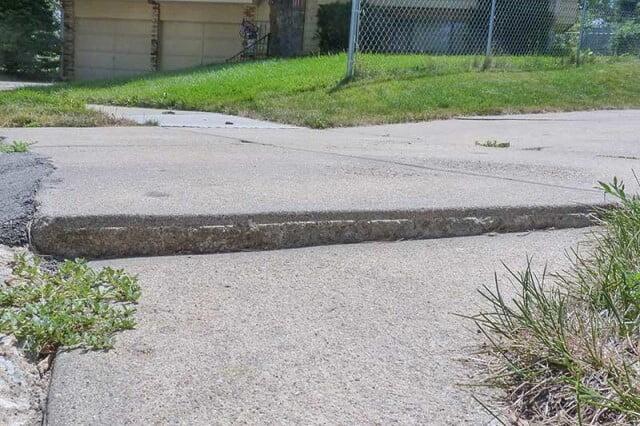Why Polyurethane Injection is Better Than Mudjacking
Consider these features when choosing a concrete leveling solution to repair your uneven concrete driveway, walkway, or patio.

Sunken, uneven concrete around your home is an eyesore and trip hazard, so it's critical to fix your sidewalk, driveway, or patio with a durable, attractive, long-lasting solution.
Sinking Outdoor Concrete: Common Causes
Despite its reputation as one of the most durable construction materials around, concrete can develop cracks and other types of problems over time. Shrinkage during curing, chemical corrosion, or normal wear and tear can cause cracks in concrete that can grow in size and severity if left untreated. The best way to repair cracks in your concrete driveway, patio, or sidewalk depends on the type of crack and what caused it.
If the problem is surface cracks and small cracks narrower than ¼ inch, these can usually be fixed with sealant and resurfacing products.
If a section of concrete settles and sinks, it can cause an unsightly crack and uneven driveway, walkway, or patio surface that can be a tripping hazard. Tree roots can push up a section of concrete, but when a section sinks, it’s usually caused by eroded soil under the slab. When the soil beneath your concrete compacts or washes out, it leaves a void into which the heavy concrete slab can sink.
Options for Raising Your Sunken Concrete
If most of your concrete is in good shape (i.e., without severe cracking or crumbling), slabjacking may be a more cost-effective and less disruptive option than replacing your uneven concrete. Slabjacking is the general name used to describe the process of “lifting” a slab that’s sunken due to soil settlement. There are two primary slabjacking methods used by concrete leveling contractors: mudjacking and polyurethane foam lifting.
Mudjacking
The traditional method of lifting concrete, referred to as mudjacking, uses a mixture of sand, cement, and other materials to make a “mud-like” substance referred to as a “slurry.” The slurry is then pumped through holes drilled into the concrete.
Polyurethane Foam Injection
In recent years, the use of expanding polyurethane foam instead of a slurry has become a common alternative to traditional mudjacking. Using polyurethane to lift concrete is often referred to as “polyjacking.” The process for both methods is similar. First, holes are drilled in the slab that’s being raised. Then, the material is injected through the holes to fill the voids beneath the slab. Finally, the holes are patched once the solution has cured.
Choosing the Best Concrete Leveling Solution: Factors to Consider
While mudjacking and polyurethane injection each have pros and cons, there are a few things to consider when choosing the best concrete leveling solution for your project. This handy infographic explains the major differences between mudjacking and the PolyLevel system, a popular polyurethane foam leveling solution. Keep reading below for more information on each of the major considerations.
-
Cure time
Faster curing, or drying time, is ideal for areas around your home with high traffic, including your driveway or pathways. The amount of time it takes the concrete to cure depends on several factors, including the size of the area, how much material is used, and the weather. Colder temperatures require a longer cure time. After the mudjacking slurry is injected through the concrete slab, it typically takes a full day to cure, before the concrete is weight-bearing. Polyurethane cures in just 15 minutes for most residential applications.
-
Longevity
The weight of the material used to raise sunken concrete makes a significant difference in how long the repair will last. The weight of heavy concrete on top of weak or eroded soil is typically what causes a slab to settle in the first place. Adding additional weight on top of this can cause further settling and sinking. Mudjacking slurry can weigh as much as 100 pounds per cubic foot. In comparison, expanding polyurethane weighs between 2 and 4 pounds per cubic foot.
Mudjacking material isn’t waterproof. If cracks and joints aren’t sealed properly, water can seep below the concrete, causing the mudjacking material to wash out. This can leave a void beneath the concrete, causing it to sink again. Because of this, mudjacking isn’t an ideal solution for lifting concrete in areas exposed to significant amounts of water - including most driveways, sidewalks, or patios. Unlike a “mud” or slurry, the closed-cell polyurethane injection foam used to level concrete doesn’t erode once in place. The material strengthens sub-soils and expands in all directions to fill voids beneath the slab. This helps fix underlying problems that cause concrete to sink and prevents future settlement.
-
Appearance
What the concrete looks like after the leveling is complete is important. The two-part polymer material used in polyurethane foam leveling is injected through holes that are 5/8” or smaller - about the size of a penny. Mudjacking holes are typically between 1” and 2” - about the size of a soda can. The smaller hole size required for polyurethane injection often provides a cleaner, more attractive concrete surface.
Don't Let Sinking Concrete Get Worse: Call Your PolyLevel® Expert Today!
When you’re dealing with uneven concrete surfaces around your home, it’s important to consider your repair options and invest in a solution that’s going to give you a long-lasting and attractive result that can increase the value of your home. Handy homeowners can handle some concrete repair jobs, however, concrete leveling and concrete lifting should be left to a professional.
Learn how PolyLevel® can quickly and effectively raise the sunken concrete around your home by scheduling your free concrete leveling estimate today!






